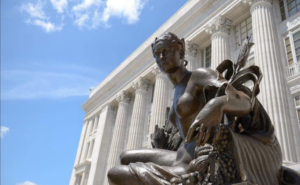9:35
News Story
Swing states see newcomers as Americans move from blue to red counties

Attendees cheer at the west Michigan city of Grand Haven’s first Pride Fest in June. The surrounding county of Ottawa had more people moving in than any other in the swing state. Like many other fast-growing counties, Ottawa is staunchly Republican but becoming more Democratic (Kristen Norman/The Associated Press).
In recent years, millions of people across the United States have moved from Democratic cities to Republican suburbs, complicating the politics of swing states in a pivotal election year, according to a Stateline analysis.
Republican suburban counties in four swing states — Georgia in the South and Michigan, Pennsylvania and Wisconsin in the Midwest — gained the most new arrivals; heavily Democratic cities lost the most. In Western swing states Arizona and Nevada, meanwhile, the biggest people magnets have been slightly Democratic cities that are expected to be hotly contested.
Those shifts reflect a nationwide trend: In Republican counties, as defined by the 2020 presidential vote, 3.7 million more people have moved in than have left since 2020, while Democratic counties had a net loss of 3.7 million, according to a Stateline analysis of U.S. Census Bureau estimates and county presidential election data kept by the University of Michigan.
The U.S. Census Bureau estimates released in March included people who moved within the country between mid-2020 and mid-2023, a time of pandemic dislocations, lockdowns in big cities, and the rise of remote work that fed a search for affordable housing in less crowded and more scenic settings. Those settings, as it turns out, also tend to be more conservative. The census numbers do not include births or immigration.
Whether the newcomers will vote Democratic this year, or whether they were disenchanted with Democratic policies in their former homes and will vote Republican, remains to be seen. The changes might affect local and congressional races the most, but even a few movers crossing state lines could sway presidential vote totals in swing states.
“We are looking at an election to be determined by a shift of such small numbers of people in each of these states that a few thousand votes in any one state can impact the electoral vote there,” said David Schultz, a political science professor at Hamline University in Minnesota who has edited and helped write several books on presidential swing states.
The counties gaining the most movers in Georgia (Forsyth County), Michigan (Ottawa County), Pennsylvania (Cumberland County) and Wisconsin (Waukesha County) were solidly for then-incumbent President Donald Trump in 2020. But in the three Midwest counties, Joe Biden had the best showing for a Democrat since Lyndon Johnson in 1964.
Politics in a changing county
In some of the growing counties, there has been tension as new residents bring their own expectations.
“People keep moving here because they like it, then they try to make it like the place they left,” said David Avant, who runs a business networking website in Forsyth County, Georgia. His county gained about 17,000 new arrivals between mid-2020 and mid-2023, according to the Stateline analysis.
Politics might not yet be changing in some of the red counties surveyed. In Michigan, Doug Zylstra became the first Democrat elected in almost 50 years to the 11-member Ottawa County Board of Commissioners in 2018 and was reelected in 2022, but the commission took a more conservative turn in 2023 when a new majority took office.
“The people of Ottawa County chose to replace the previous Republican-majority board, which promoted Democratic ideology and practices,” said Sylvia Rhodea, one of the new Republicans on the commission.
In a January 2023 meeting, Rhodea criticized the previous board’s diversity, equity and inclusion program as “based on the premise that county resident characteristics of being 90% white and largely conservative were problematic for businesses” and as one that “seeks to replace the American value of equality with the Marxist value of equity.”
“There is not a racial divide in Ottawa County, there is an ideological divide. The welcoming of people will continue, but the ideology that tries to divide us has to end,” Rhodea said in the meeting.
The Rev. James Ellis III, who is Black and who moved to Ottawa County in April 2023, lives in the area that elected the county’s sole Democrat. He said the “racial divide” remark “feels inaccurate to me, not to mention unhelpful.” And while he said he has no party affiliation, he thinks “people on every side have a hard time listening to each other.”
Ellis grew up in Maryland and has lived in cities including Washington, D.C., and British Columbia, Canada. He attended a local seminary in Ottawa County.
“Ottawa County is not a utopia. It is an area full of wonderful citizens, lakeshore living, lots of churches and winter sports, and yet simultaneously it has power dynamics and inequities like any place that need addressing,” said Ellis, of Maplewood Reformed Church. The county’s population is about 83% white with small but growing Asian, Black and Hispanic populations.
‘They vote for the same thing’
In Wisconsin, affluent and suburban Waukesha County has gained about 5,200 movers, while urban Milwaukee County has lost 37,000. Still, that’s not likely to change the politics of either county soon, said Steve Styza, a Republican who won an open seat on the Waukesha County Board of Supervisors in Tuesday’s election.
“Democrats are definitely trying to make as big of a push as they can to turn the most conservative counties in our state blue or purple and try to gain some kind of foothold because it is strategically important,” Styza said before the election. “If I was on the other team, I’d be trying to do the same thing.”
Waukesha County voted almost 60% for Trump in 2020, though the roughly 38.8% vote for Biden was the highest share for a Democrat since 1964. The county’s 2022 vote for Democratic Gov. Tony Evers was slightly higher at 39.4%. Milwaukee County voted 69% for Biden in 2020 and 71% for Evers in 2022.
Like Avant in Georgia, Styza said that Democratic newcomers sometimes pose a threat to the suburban lifestyle that drew them there in the first place.
“They say, ‘Well, I gotta get out of there because of what’s going on,’ and then they vote for the same thing in a different place and then wonder why things turn out poorly,” Styza said.
In the Western swing states of Arizona and Nevada, the politics are similar, but the largest cities are still growing fast. Arizona’s Maricopa County, home of Phoenix, voted Democratic in 2020 for the first time since 1948, when Harry Truman carried the county.
In Nevada, Clark County, the home of Las Vegas, has voted Democratic for president since 1992, but the Republican vote has been growing since 2008, reaching 44% for Trump in 2020. Some of the new Republican strength could be transplants from California’s conservative inland region east of Los Angeles, said David Damore, a political science professor at the University of Nevada, Las Vegas.
“In contrast, Reno, which has been voting more Democratic in recent cycles, is attracting more liberal Californians from Sacramento and the Bay Area,” Damore said. “Statewide, the vote share that the Democrats lost in Las Vegas, they gained in Reno.”
Some conservative scholars argue that residential moves from blue to red areas show a political preference or at least an attraction to the results of conservative policies.
“Every day, Americans appear to have a clear preference about the sort of state government they want. Far from flocking to states that have imposed mandates and lockdowns, they have freely chosen to move to states that focus on securing the mandates of liberty,” Jeffrey Anderson, president of the conservative nonprofit American Main Street Initiative, wrote in an analysis of state-by-state moving statistics published in City Journal in January.
Other demographers see the movement of people as a search for housing and jobs that doesn’t take politics into account.
“Domestic migration [moving] across state and metro areas is not strongly affected by politics but by labor market and housing conditions,” said William Frey, a demographer at The Brookings Institution. He added that movers from blue to red states “could make their destination states less red — Arizona and Nevada are good examples.”
Stateline is part of States Newsroom, a nonprofit news network supported by grants and a coalition of donors as a 501c(3) public charity. Stateline maintains editorial independence. Contact Editor Scott S. Greenberger for questions: [email protected]. Follow Stateline on Facebook and Twitter.
Our stories may be republished online or in print under Creative Commons license CC BY-NC-ND 4.0. We ask that you edit only for style or to shorten, provide proper attribution and link to our website. AP and Getty images may not be republished. Please see our republishing guidelines for use of any other photos and graphics.




